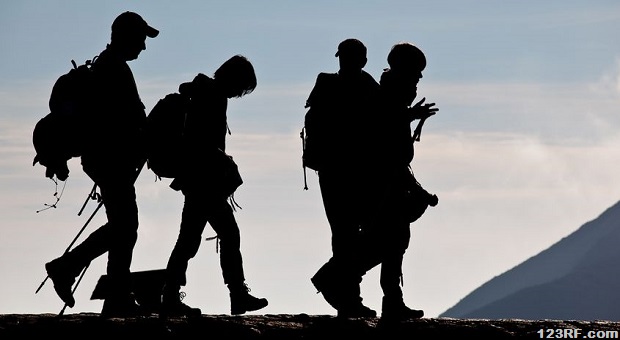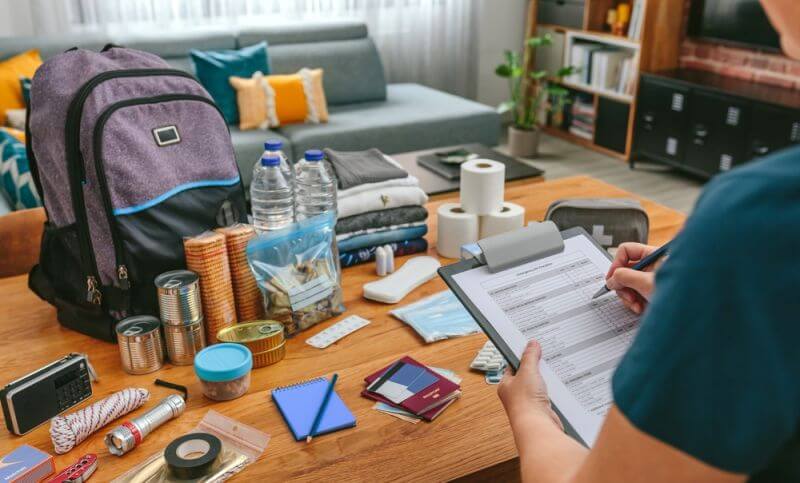After footwear, pack weight, fit and weight distribution are important factors when leaving on foot to your bug-out location, in order to save yourself and your family from disaster. So much so that their basic principles apply across the board in most other alternative modes of transport as well.
Contrary to conventional wisdom, ideal pack weight for survival scenarios is both relative and subjective: saying that everyone’s pack should be x% of their body weight across the board is somewhat naïve.
What to Consider When Packing
First of all, there are factors you must take into account for each of the group member that you belong to:
- the overall fitness level
- lean body mass
- body fat percentage
- physical size
- cardiovascular fitness
- backpacking experience
- level of mental toughness
- determination of the individual.
{adinserter usdeception}Travel parameters such as how long you will travel, how far, the terrain conditions, grades, distance between water sources, distance between supply caches, and the likelihood of various forms of resupply must be considered also.
Other factors to evaluate are the group size and makeup to make adjustments for families, children, elderly group members and group members with disabilities.
What about Logistics?
Consider group logistics since you will be a more capable survival group if you have the proper group equipment – tools such as an axe, entrenching tool, bow saw blades, a stove or two, shelters and other equipment that is very useful but can be shared.
Determine beforehand what group equipment will be needed and distribute it amongst the group members since your individual loads will be lighter if each person doesn’t have to carry every article redundantly.
Failure to coordinate group logistics usually results in everyone carrying everything that anyone could possibly need, creating over-redundancy and loads of excess weight or the omission of high value group gear or force multipliers do to increased individual pack weight.
Don’t underestimate the importance of security-related factors such as:
- Chain of command
- Small unit tactics
- Marching order
- SOP (standard operating procedure)
- Weapons distribution
- Ammo distribution
- Communications
- Navigation
Plan and Prepare to Travel Undetected
Plan the trip and prepare for it ahead of time. Do security considerations and environmental conditions dictate day or night travel? Will the group need to E&E (escape & evade) as it travels? If so, precautions such as noise, light, spore (track) and litter discipline must be exercised.
This may mean packing extra magazines & E&E-specific gear such as Wayne Carlton’s Cat’s Paws (sometimes referred to as super sneakers). They are basically an oversized felt sole that attaches securely over your boots. They offer the advantages of leaving virtually no spore, radically altering any tracks that you do leave, and helping you make less noise as you walk while hunting or needing to E&E.

Diversionary tactics such as such as making direction changes in rocky terrain or on stretches of pavement where you won’t leave visible tracks to follow will help thwart those who may be tracking you. This will cause your pursuers to have to walk ever larger circles from the point where they lost your trail until they can pick it up again.
Having someone in your group volunteer to study E&E tactics and cross-training the rest of your group ahead of time may pay off big down the road in the form of avoided conflicts.
All of the previous factors must be considered holistically to determine ideal pack weight per individual.
How Much Is Too Much?
Taking all of these factors into consideration, target pack weight may range anywhere from 15%-50% of target body weight for your build and height. That’s 15%-50% of what you should weigh.
If you’re overweight, calculating your pack weight based on your body weight will yield a pack that’s too heavy and you will suffer miserably under its weight on top of the extra weight that you are already carrying.
If members bring too much redundant or unnecessary gear, the group load should be adjusted en route, and excess gear should be bartered or cached along the way.
CLICK HERE to find out more about preparing for your bug out after an economic collapse.
This article has been written by Cache Valley Prepper for Survivopedia.









Big Country | June 18, 2014
|
Well done. A few typos but a sound and well written piece. You get the Ranger stamp of approval.
Cache Valley Prepper | June 19, 2014
|
Thank you Big Country! I appreciate you reading and commenting too.
Pastor William | June 19, 2014
|
When you are bugging out and on the move,if you live in the South where average temp during the day is90 degrees would it be wiser to travel at night ???God Bless America!!!!
Cache Valley Prepper | June 19, 2014
|
Absolutely Pastor William. This is just one of several short bugout articles on this topic so be sure to watch for more on this topic.
If you’re trying to stay undetected. It’s best to move under the cover of darkness on overcast nights or at times there is little moonlight, and in windy or inclement conditions. That way it will be harder to hear your group over the noise of the wind and with wind moving trees and brush it will be harder to detect your movement. Even better if wind and precipitation help obliterate your tracks.
Thanks for reading and commenting Pastor. Check back for more articles on the subject. – Cache
Rambuff | June 19, 2014
|
Not a bad article….however, if you (we) have bugout concerns including elderly, infirm or handicapped, and whether or not one can carry their load, you are caught/dead already. The ONY WAY to ensure one can carry all they need to is to practice, practice, PRACTICE!! Without this, it does not remain a strategic withdrawal – it is a rout, and the participants are nothing more than refugees.
Equal to or even MORE important than the weight carried is the issue of feet and footwear. If the boots are NOT fully broken in, the walker (refugee) will hold up the group, jeopardizing everyone in the group, perhaps fatally.
You mentioned having caches, or supply areas enroute – a GOOD call – I think not enough is made of this kind of thing, generally.
However, a bugout effectiveness is only as good as the weakest or most infirm member… a re-thinking of the situation may be in order…such as a pre-emptive, PLANNED evac BEFORE it becomes an emergency situation. Of course, one cannot prepare 100% for 100% of all situations, 100% of the time…and so we prepare for what we can foresee, and hope that God takes up the slack.
One last note: Even more critical than what you are taking is WHERE you are going; an evacuee without a CONFIRMED destination (you own the place, others are waiting/expecting you) you are nothing more than a REFUGEE…. and a refugee’s chances of survival are near zero, as you have NO options.
Cache Valley Prepper | June 19, 2014
|
Rambuff,
Everything you said rang true with me. Keep checking back since this is just one article of series on the topic because my original article had to broken down into many parts. 🙂
I agree that there is far more to bugging out than could possibly be squeezed in here. The other articles talk about Foot Care, Transport Tools such as hand carts, sleds or travois to reduce the load carried by the security element and to carry casualties, infirm group members or their gear, The Bug Out Destination, Cold Weather Travel, E&E tactics & more so hang in there with me, there’s more to follow.
Thanks for reading and commenting,
-CVP
Pingback:5 Online Tools to Use when Prepping | July 11, 2014
|
Pingback:How to Escape Your Tail and Avoid Being Followed | Survival skills, survival guns, survival guide | November 26, 2014
|
Great Grey | March 30, 2015
|
The problem of redundant items is that when traveling alone you need things that as group you may only need one or two of but, if you are separated from the group you well need, i.e. a walkie-talkie and you don’t where and the rest of your group will be. So what you need to get the group together and what you need as group can certainly be different, makes for difficult balancing act.
Pingback:How To Test Your Water For Pollution Agents | Survival skills, survival guns, survival guide | May 19, 2015
|
Pingback:How To Test Your Water For Pollution Agents | The Prepper Dome | May 23, 2015
|